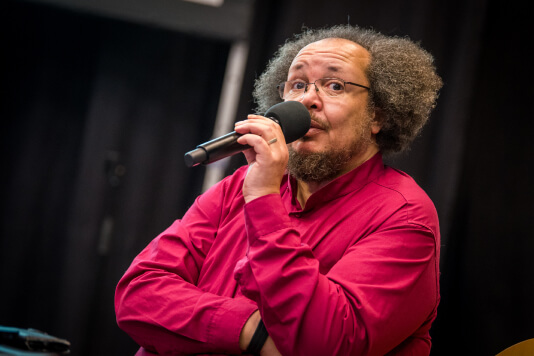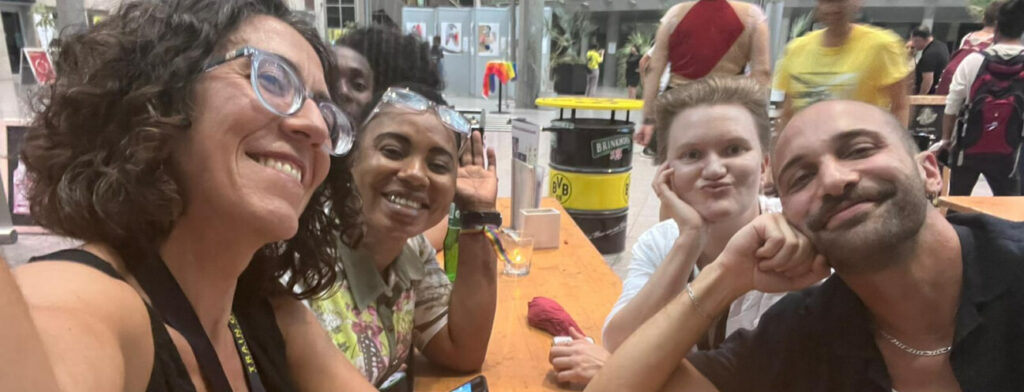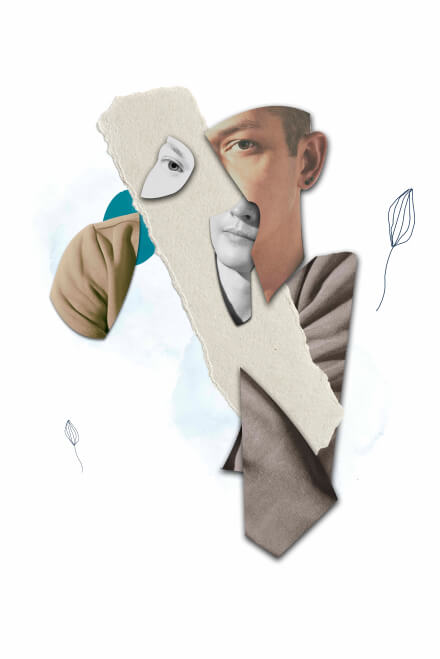Tsepo Bollwinkel
Tsepo Bollwinkel is a Black South African in exile in Germany, non binary with a history of transition, works as a musician and as a speaker on social justice issues - and wrote the foreword for this project.

pain
Schmerz
To be marginalized and racialized in our society, perhaps to have a history of flight and then at the same time not to conform to the sexual or gender norms, that means exclusion on so many levels all at the same time. It means discrimination and a very real daily risk from externally perceptible characteristics such as
phenotype, name or accent, including residence status, gender expression, choice of partner or type of family. Each of these social exclusions is violent because it denies people affected their human right to be perceived as an unique and infinitely valuable individual - an individual who is always so much more than a sum of migration history and queerness, but who at the same time has a right that his*/her* reality of racism and queer hostility is recognized.
"You're wrong." "You don't belong to us." "You are a disgrace."
"You cannot make your persecution credible." "You don't have to be openly gay." "You are just a liability here."
"I am gay so I can't be a racist." "Queerness is an invention to exterminate us." "I've always wanted to do it with an exotic body."
Each of these exclusions inscribes itself into body and mind of the invalidated, creating wounds and deep pain.
pride
Stolz
And yet - we[1] have always been there!
People who love beyond the norms of heterosexuality, who live beyond the ideas of the binary and who create families beyond monogamous and nuclear forms of relationships have been existing always and everywhere on this planet. We're not a new or trendy entity, or rare or weird or freaks.
What is much more new is the violent presentation and enforcement of heteronormative norms and the refusal to include those who today often call themselves queers into all societies.
We have always been there. And yet - there are many of us!
Very stable about 10% of humanity live and love beyond heteronormative ideas of gender and sexuality. That is in numbers about 780 million people worldwide and 8.3 million in Germany. 780 million people are not a rare minority, no exceptions to any rule, no "weird or colorful birds". 780 million people are an integral part of humanity.
And no, not all of us are visible, can afford visibility, because visibility brings with it the risk of exclusion and violence. This is especially true for people who are racialized or migrantized. Here, many of us experience exclusions (and violence) from all directions: from the white and heternormative majority, from queer communities, and also from people who actually have so much in common through stories of origin or flight or through racialization.
It is time for everyone to realize - including ourselves:
We have always been there. And we are many.
The "we" includes the author, who, like the portrayed and the artist, is racialized and queer, and who is a child of refugees.
pose
sich zeigen
And yet - we are unique, precious and beautiful!
This is what makes this exhbition so wonderful: It shows us as unique individuals with a self-evident claim to self-expression, to our own voice and our own path, to vulnerability and pride, to inviolable human dignity.
In the pictures and texts, people reveal themselves to be so much more than a sum of experiences of exclusion or discrimination features, but as complete, creative and worthy persons and personalities.
We have always been there. We are many. And we are unique, precious and beautiful.
In the pictures by Nora Hase and the texts of the portrayed, people who have been multiple excluded create not only visibility but also a space of dignity, strength and (self) love.
It is essential and necessary that the process that led to these works of art was not a look from the outside at those who
were often discriminated against, that it is not talking about people, but that texts and images are part of an empowerment process, i.e. an act of self-empowerment. This contributes to the special quality of this exhibition as well as the fact that the artist Nora Hase, as a queer and Black person, shares many of the experiences of those portrayed.
Dignity, strength and (self) love make the portrayed people beautiful, make their texts beautiful, make Nora Hase's pictures beautiful, and also make the empowerment processes that accompany this exhibition beautiful.
I wish that this beauty is reflected in the experiences of all those who look at it as a recognition of their own uniqueness, preciousness and beauty. And I hope that this recognition will contribute to the self-evident social recognition of queer and racialized poeple.
Tsepo Bollwinkel

Antidiscrimination office (ADB) rubicon
The ADB rubicon advocates the rights and visibility of lgbtiq+ people with international history. The ADB rubicon offers advice on a case-by-case basis with a focus on racism and LGBTIQ+ hostility, as well as education and networking.
baraka – a place for international queers
baraka has been an open meeting place for queer people from all over the world at the rubicon in Cologne since 2005.
A place to get to know people from your own country of origin and from so many other countries, to exchange ideas and to support others.
The meeting is organized by employees of rubicon in Cologne.

The exhibits
Are you curious and do you want to support international queers and show them that they are not alone? 15 queers worked on this project for a year to make a clear statement against discrimination and racism. The empowerment process was challenging, but the participants worked with photographer Nora Hase to create their own picture collages, write texts, and empower themselves through exchange with each other. You can see their experiences of pain and fragmentation in the full exhibition.

